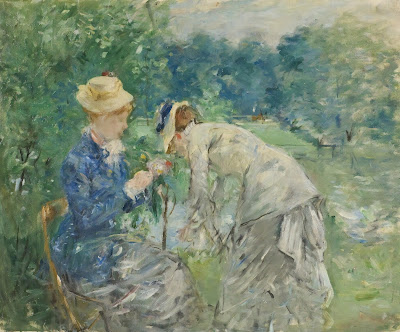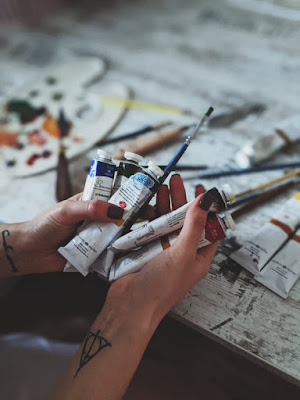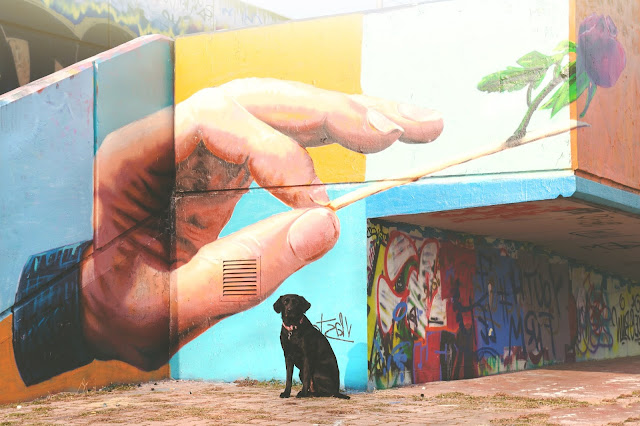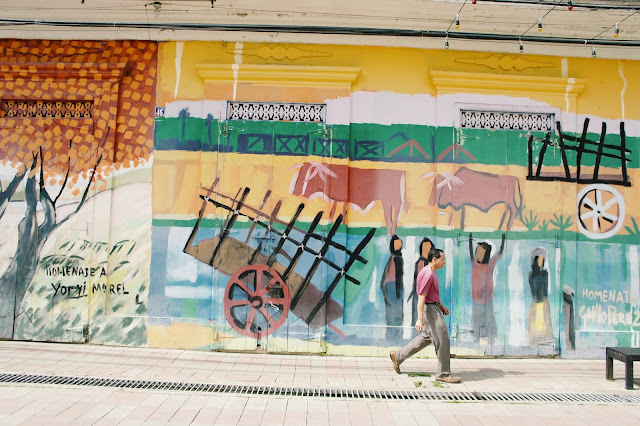Oil paintings
Oil paint is a type of slow-drying paint that consists
of particles of pigment suspended in
a drying oil, commonly linseed oil. The viscosity of
the paint may be modified by the addition of a solvent such as turpentine or white spirit, and varnish may be added
to increase the glossiness of the dried
oil paint film.
Oil paints have been used in Europe since the 12th century for simple decoration, but were not widely adopted as an artistic medium until the early 15th century. Common modern applications of oil paint are in finishing and protection of wood in buildings and exposed metal structures such as ships and bridges.
Its hard-wearing properties and luminous colors make it desirable for both interior and exterior use on wood and metal. Due to its slow-drying properties, it has recently been used in paint-on-glass animation. Thickness of coat has considerable bearing on time required for drying: thin coats of oil paint dry relatively quickly.
Oil paints have been used in Europe since the 12th century for simple decoration, but were not widely adopted as an artistic medium until the early 15th century. Common modern applications of oil paint are in finishing and protection of wood in buildings and exposed metal structures such as ships and bridges.
Its hard-wearing properties and luminous colors make it desirable for both interior and exterior use on wood and metal. Due to its slow-drying properties, it has recently been used in paint-on-glass animation. Thickness of coat has considerable bearing on time required for drying: thin coats of oil paint dry relatively quickly.
Oil painting
Oil
painting is the process of painting with pigments with
a medium of drying oil as the binder.
Commonly used drying oils include linseed oil, poppy seed
oil, walnut oil, and safflower oil.
The choice of oil imparts a range of properties to the oil paint,
such as the amount of yellowing or drying time. Certain differences, depending
on the oil, are also visible in the sheen of the paints. An artist might use
several different oils in the same painting depending on specific pigments and
effects desired.
The paints themselves also develop a particular consistency depending on the medium. The oil may be boiled with a resin, such as pine resin or frankincense, to create a varnish prized for its body and gloss.
The paints themselves also develop a particular consistency depending on the medium. The oil may be boiled with a resin, such as pine resin or frankincense, to create a varnish prized for its body and gloss.
Although oil
paint was first used for Buddhist paintings by painters in central and
western Afghanistan sometime between the fifth and
tenth centuries,it
did not gain popularity until the 15th century.
Its practice may have migrated westward during the Middle Ages. Oil paint eventually became the principal medium used for creating artworks as its advantages became widely known. The transition began with Early Netherlandish painting in Northern Europe, and by the height of the Renaissance oil painting techniques had almost completely replaced the use of tempera paints in the majority of Europe.
Its practice may have migrated westward during the Middle Ages. Oil paint eventually became the principal medium used for creating artworks as its advantages became widely known. The transition began with Early Netherlandish painting in Northern Europe, and by the height of the Renaissance oil painting techniques had almost completely replaced the use of tempera paints in the majority of Europe.
In recent
years, water miscible oil paint has become
available. Water-soluble paints are either engineered or an emulsifier has
been added that allows them to be thinned with water rather than paint thinner,
and allows, when sufficiently diluted, very fast drying times (1–3 days) when
compared with traditional oils
Techniques
Traditional
oil painting techniques often begin with the artist sketching the subject onto
the canvas with charcoal or thinned paint. Oil paint is
usually mixed with linseed oil, artist grade mineral
spirits, or other solvents to make the paint thinner, faster or
slower-drying.
(Because these solvents thin the oil in the paint, they can also be used to clean paint brushes.) A basic rule of oil paint application is 'fat over lean', meaning that each additional layer of paint should contain more oil than the layer below to allow proper drying.
If each additional layer contains less oil, the final painting will crack and peel. This rule does not ensure permanence; it is the quality and type of oil that leads to a strong and stable paint film.
(Because these solvents thin the oil in the paint, they can also be used to clean paint brushes.) A basic rule of oil paint application is 'fat over lean', meaning that each additional layer of paint should contain more oil than the layer below to allow proper drying.
If each additional layer contains less oil, the final painting will crack and peel. This rule does not ensure permanence; it is the quality and type of oil that leads to a strong and stable paint film.
There are many
other media that can be used with the oil, including cold wax, resins, and
varnishes. These additional media can aid the painter in adjusting the
translucency of the paint, the sheen of the paint, the density or 'body' of the
paint, and the ability of the paint to hold or conceal the brushstroke. These
aspects of the paint are closely related to the expressive capacity of oil
paint.
Traditionally,
paint was transferred to the painting surface using paintbrushes,
but there are other methods, including using palette
knives and rags. Oil paint remains wet longer than many other
types of artists' materials, enabling the artist to change the color, texture
or form of the figure. At times, the painter might even remove an entire layer
of paint and begin anew.
This can be done with a rag and some turpentine for a time while the paint is wet, but after a while the hardened layer must be scraped. Oil paint dries by oxidation, not evaporation, and is usually dry to the touch within a span of two weeks (some colors dry within days). It is generally dry enough to be varnished in six months to a year.
This can be done with a rag and some turpentine for a time while the paint is wet, but after a while the hardened layer must be scraped. Oil paint dries by oxidation, not evaporation, and is usually dry to the touch within a span of two weeks (some colors dry within days). It is generally dry enough to be varnished in six months to a year.
Process
Oil
paint is made by mixing pigments of colors with an oil medium. Different colors
are made, or purchased premixed, before painting begins, but further shades of
color are usually obtained by mixing small quantities together as the painting
process is underway.
An artist's palette, traditionally a thin wood board held in the hand, is used for holding and mixing paints of different colors. Pigments may be any number of natural or synthetic substances with color, such as sulphides for yellow or cobalt salts for blue.
Traditional pigments were based on minerals or plants, but many have proven unstable over long periods of time; the appearance of many old paintings today is very different from the original. Modern pigments often use synthetic chemicals. The pigment is mixed with oil, usually linseed, but other oils may be used. The various oils dry differently, which creates assorted effects.
An artist's palette, traditionally a thin wood board held in the hand, is used for holding and mixing paints of different colors. Pigments may be any number of natural or synthetic substances with color, such as sulphides for yellow or cobalt salts for blue.
Traditional pigments were based on minerals or plants, but many have proven unstable over long periods of time; the appearance of many old paintings today is very different from the original. Modern pigments often use synthetic chemicals. The pigment is mixed with oil, usually linseed, but other oils may be used. The various oils dry differently, which creates assorted effects.
Traditionally,
artists mixed their own paints from raw pigments that they often ground
themselves and medium. This made portability difficult
and kept most painting activities confined to the studio.
This changed in the 1800s, when tubes of oil paint became widely available following the American portrait painter John Goffe Rand's invention of the squeezable or collapsible metal tube in 1841 (the year of Claude Monet's birth). Artists could mix colors quickly and easily, which enabled, for the first time, relatively convenient plein air painting (a common approach in French Impressionism).
This changed in the 1800s, when tubes of oil paint became widely available following the American portrait painter John Goffe Rand's invention of the squeezable or collapsible metal tube in 1841 (the year of Claude Monet's birth). Artists could mix colors quickly and easily, which enabled, for the first time, relatively convenient plein air painting (a common approach in French Impressionism).
A brush is most
commonly employed by the artist to apply the paint, often over a sketched
outline of their subject (which could be in another medium). Brushes are made
from a variety of fibers to create different effects.
For example, brushes made with hog bristle might be used for bolder strokes and impasto textures. Fitch hair and mongoose hair brushes are fine and smooth, and thus answer well for portraits and detail work.
Even more expensive are red sable brushes (weasel hair). The finest quality brushes are called "kolinsky sable"; these brush fibers are taken from the tail of the Siberian weasel. This hair keeps a superfine point, has smooth handling, and good memory (it returns to its original point when lifted off the canvas), known to artists as a brush's "snap".
Floppy fibers with no snap, such as squirrel hair, are generally not used by oil painters.In the past few decades, many synthetic brushes have been marketed. These are very durable and can be quite good, as well as cost efficient.
For example, brushes made with hog bristle might be used for bolder strokes and impasto textures. Fitch hair and mongoose hair brushes are fine and smooth, and thus answer well for portraits and detail work.
Even more expensive are red sable brushes (weasel hair). The finest quality brushes are called "kolinsky sable"; these brush fibers are taken from the tail of the Siberian weasel. This hair keeps a superfine point, has smooth handling, and good memory (it returns to its original point when lifted off the canvas), known to artists as a brush's "snap".
Floppy fibers with no snap, such as squirrel hair, are generally not used by oil painters.In the past few decades, many synthetic brushes have been marketed. These are very durable and can be quite good, as well as cost efficient.
Brushes come in
many sizes and are used for different purposes. The type of
brush also makes a difference. For example, a "round" is a pointed
brush used for detail work. "Flat" brushes are used to apply broad
swaths of color. "Bright" is a flat brush with shorter brush hairs,
used for "scrubbing in". "Filbert" is a flat brush with
rounded corners.
"Egbert" is a very long, and rare, filbert brush. The artist might also apply paint with a palette knife, which is a flat metal blade. A palette knife may also be used to remove paint from the canvas when necessary. A variety of unconventional tools, such as rags, sponges, and cotton swabs, may be used to apply or remove paint. Some artists even paint with their fingers.
"Egbert" is a very long, and rare, filbert brush. The artist might also apply paint with a palette knife, which is a flat metal blade. A palette knife may also be used to remove paint from the canvas when necessary. A variety of unconventional tools, such as rags, sponges, and cotton swabs, may be used to apply or remove paint. Some artists even paint with their fingers.
First recorded use
The oldest known oil
paintings date from 650 AD, found in 2008 in caves in Afghanistan's Bamiyan
Valley, "using walnut and poppy seed oils."
Classical and medieval period
Though the ancient
Mediterranean civilizations of Greece, Rome,
and Egypt used vegetable oils, there is little evidence
to indicate their use as media in
painting. Indeed, linseed oil was not used as a medium
because of its tendency to dry very slowly, darken, and crack, unlike mastic and wax (the latter of
which was used in encaustic painting).
Greek writers such
as Aetius Amidenus recorded recipes involving
the use of oils for drying, such as walnut, poppy, hempseed, pine nut, castor,
and linseed. When thickened, the oils became resinous and could be used
as varnish to
seal and protect paintings from water. Additionally, when yellow pigment was
added to oil, it could be spread over tin foil as
a less expensive alternative to gold leaf.
Early
Christian monks maintained
these records and used the techniques in their own artworks. Theophilus Presbyter, a 12th-century
German monk, recommended linseed oil but advocated against the use of olive oil due
to its long drying time. Oil paint was mainly used as it is today in house
decoration, as a tough waterproof cover for exposed woodwork, especially
outdoors.
In the 13th century,
oil was used to detail tempera paintings. In the 14th century, Cennino
Cennini described a painting technique utilizing tempera
painting covered by light layers of oil. The slow-drying
properties of organic oils were
commonly known to early painters. However, the difficulty in acquiring and
working the materials meant that they were rarely used (and indeed the slow
drying was seen as a disadvantage).
Renaissance on wards
As public preference
for naturalism increased, the quick-drying tempera paints
became insufficient to achieve the very detailed and precise effects that oil
could achieve. The Early Netherlandish painting of the
15th century saw the rise of the panel
painting purely in oils, or oil painting,
or works combining tempera and oil painting, and by the 16th century easel
painting in pure oils had become the norm, using much the same techniques and
materials found today.
The claim by Vasari that Jan van Eyck "invented" oil painting, while it has cast a long shadow, is not correct, but van Eyck's use of oil paint achieved novel results in terms of precise detail and mixing colors wet-on-wet with a skill hardly equaled since. Van Eyck's mixture may have consisted of piled glass, calcined bones, and mineral pigments boiled in linseed oil until they reached a viscous state—or he may have simply used sun-thickened oils (slightly oxidized by Sun exposure). He left no written documentation.
The claim by Vasari that Jan van Eyck "invented" oil painting, while it has cast a long shadow, is not correct, but van Eyck's use of oil paint achieved novel results in terms of precise detail and mixing colors wet-on-wet with a skill hardly equaled since. Van Eyck's mixture may have consisted of piled glass, calcined bones, and mineral pigments boiled in linseed oil until they reached a viscous state—or he may have simply used sun-thickened oils (slightly oxidized by Sun exposure). He left no written documentation.
The Flemish-trained
or influenced Antonello da Messina, who Vasari wrongly
credited with the introduction of oil paint to Italy, does
seem to have improved the formula by adding litharge,
or lead (II) oxide. The new mixture had a honey-like consistency and better
drying properties (drying evenly without cracking).
This mixture was known as oglio cotto—"cooked oil." Leonardo da Vinci later improved these techniques by cooking the mixture at a very low temperature and adding 5 to 10% beeswax, which prevented darkening of the paint. Giorgione, Titian, and Tintoretto each may have altered this recipe for their own purposes.
This mixture was known as oglio cotto—"cooked oil." Leonardo da Vinci later improved these techniques by cooking the mixture at a very low temperature and adding 5 to 10% beeswax, which prevented darkening of the paint. Giorgione, Titian, and Tintoretto each may have altered this recipe for their own purposes.
Paint tube
The paint tube was
invented in 1841 by portrait painter John Goffe
Rand,superseding pig bladders and
glass syringesas
the primary tool of paint transport. Artists, or their assistants, previously
ground each pigment by hand, carefully mixing the binding oil in the proper
proportions.
Paints could now be produced in bulk and sold in tin tubes with a cap. The cap could be screwed back on and the paints preserved for future use, providing flexibility and efficiency to painting outdoors. The manufactured paints had a balanced consistency that the artist could thin with oil, turpentine, or other mediums.
Paints could now be produced in bulk and sold in tin tubes with a cap. The cap could be screwed back on and the paints preserved for future use, providing flexibility and efficiency to painting outdoors. The manufactured paints had a balanced consistency that the artist could thin with oil, turpentine, or other mediums.
Paint in tubes also
changed the way some artists approached painting. The artist Pierre-Auguste
Renoir said, “Without tubes of paint, there would have been
no impressionism.” For the impressionists, tubed paints
offered an easily accessible variety of colors for their plein air palettes,
motivating them to make spontaneous color choices. With greater quantities of
preserved paint, they were able to apply paint more thickly.
Carrier:
Characteristics
Traditional oil
paints require an oil that always hardens, forming a stable, impermeable film.
Such oils are called causative, or drying,
oils, and are characterised by high levels of polyunsaturated fatty acids.
One common measure of the causative property of oils is iodine number,
the number of grams of iodine one hundred grams of oil can absorb.
Oils with an iodine number greater than 130 are considered drying, those with an iodine number of 115–130 are semi-drying, and those with an iodine number of less than 115 are non-drying. Linseed oil, the most prevalent vehicle for artists' oil paints, is a drying oil.
Oils with an iodine number greater than 130 are considered drying, those with an iodine number of 115–130 are semi-drying, and those with an iodine number of less than 115 are non-drying. Linseed oil, the most prevalent vehicle for artists' oil paints, is a drying oil.
When exposed to
air, oils do not undergo the same evaporation process
that water does. Instead, they dry semisolid. The rate of this process can be
very slow, depending on the oil.The advantage
of the slow-drying quality of oil paint is that an artist can develop a
painting gradually. Earlier media such as egg tempera dried quickly, which
prevented the artist from making changes or corrections.
With oil-based paints, revising was comparatively easy. The disadvantage is that a painting might take months or years to finish, which might disappoint an anxious patron. Oil paints blend well with each other, making subtle variations of color possible as well as creating many details of light and shadow.
Oil paints can be diluted with turpentine or other thinning agents, which artists take advantage to paint in layers.There is also another kind of oil paint that is water-mixable, making the cleaning and using process easier and less toxic.
With oil-based paints, revising was comparatively easy. The disadvantage is that a painting might take months or years to finish, which might disappoint an anxious patron. Oil paints blend well with each other, making subtle variations of color possible as well as creating many details of light and shadow.
Oil paints can be diluted with turpentine or other thinning agents, which artists take advantage to paint in layers.There is also another kind of oil paint that is water-mixable, making the cleaning and using process easier and less toxic.
Sources
The
earliest and still most commonly used vehicle is linseed oil,
pressed from the seed of
the flax plant.
Modern processes use heat or steam to produce refined varieties of oil with
fewer impurities, but many artists prefer cold-pressed oils.
Other vegetable oils such as hemp, poppy seed, walnut, sunflower, safflower, and soybean oils may be used as alternatives to linseed oil for a variety of reasons. For example, safflower and poppy oils are paler than linseed oil and allow for more vibrant whites straight from the tube.
Other vegetable oils such as hemp, poppy seed, walnut, sunflower, safflower, and soybean oils may be used as alternatives to linseed oil for a variety of reasons. For example, safflower and poppy oils are paler than linseed oil and allow for more vibrant whites straight from the tube.
Extraction methods and processing
Once the oil is
extracted, additives are sometimes used to modify its
chemical properties. In this way, the paint can be made to dry more quickly (if
that is desired), or to have varying levels of gloss, like Liquin.
Modern oils paints can, therefore, have complex chemical structures; for example, affecting resistance to UV. By hand, the process involves first mixing the paint pigment with the linseed oil to a crumbly mass on a glass or marble slab.
Then, a small amount at a time is ground between the slab and a glass Muller (a round, flat-bottomed glass instrument with a hand grip). Pigment and oil are ground together 'with patience' until a smooth, ultra-fine paste is achieved. This paste is then placed into jars or metal paint tubes and labelled.
Modern oils paints can, therefore, have complex chemical structures; for example, affecting resistance to UV. By hand, the process involves first mixing the paint pigment with the linseed oil to a crumbly mass on a glass or marble slab.
Then, a small amount at a time is ground between the slab and a glass Muller (a round, flat-bottomed glass instrument with a hand grip). Pigment and oil are ground together 'with patience' until a smooth, ultra-fine paste is achieved. This paste is then placed into jars or metal paint tubes and labelled.






















































0 comments:
Post a Comment